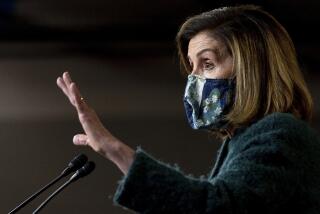They do the job
- Share via
Members of Congress were so concerned about the economy that they set aside their usual partisan differences and quickly passed a $152-billion stimulus package in February. How much the legislation’s rebates and tax breaks will juice the gross domestic product, however, is anybody’s guess. Jittery consumers may simply pocket the rebates or pay down debt when their checks arrive next month, rather than pumping money into the economy. And the tax breaks for business will yield more spending only if firms are willing and able to accelerate capital investments.
By contrast, one proven stimulus technique would be to extend unemployment benefits past the standard six-month cutoff. Every $1 spent on extended benefits would boost the economy by more than $1.50, according to Moody’s Economy.com. That’s one reason lawmakers have approved such extensions seven times in the last 50 years -- they’re not just humane, they help revive commerce. Yet Senate Republicans, backed by President Bush, blocked an effort to add a 13- to 26-week extension to this year’s stimulus package.
Now, lawmakers from both parties are trying again to extend those benefits, at a cost of about $12.7 billion over two years. It’s good policy that should be implemented now, without waiting for more economists to declare that we’re in a recession.
The unemployment insurance program is a joint effort by federal and state governments to replace part of the pay workers lose when they’re laid off. One of the main arguments against extending the benefits now is that the unemployment rate isn’t as high as it was the previous times Congress offered help. But the rate -- 5.1% in March, up from 4.6% in 2007 -- isn’t as telling as the number of people unable to find work within six months. About one out of every six unemployed workers has been without a job for more than 26 weeks -- far more than at the start of the last recession. By the end of the year, 3.5 million Americans could run out of benefits before they find work.
Those statistics may be a sign of something more troubling than a cyclical downturn. They may also reflect years of slow job growth caused by globalization and a technology-driven shift in employment opportunities. Those problems can’t be addressed by stopgap measures. A slowing economy, on the other hand, can be prodded by an increase in consumer spending. And one of the best ways to do that is to give more help to those struggling to find a job.
More to Read
Inside the business of entertainment
The Wide Shot brings you news, analysis and insights on everything from streaming wars to production — and what it all means for the future.
You may occasionally receive promotional content from the Los Angeles Times.










